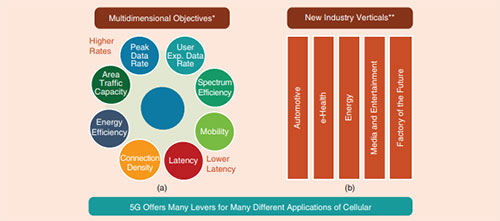
The cellular industry has just reached another milestone with the development of 5G wireless communication technology. While research in 5G is a core part of the Signal Processing for Communications and Networking (SPCOM) technical committee, it may also be found in several other technical areas. As this is also my core expertise, I have decided to discuss, in this editorial, the expected goals that 5G has and has not achieved and what might be coming in 6G cellular networks.
Cellular communication systems are constantly evolving, with new releases every one to two years. Roughly every 10 years, one of the releases is branded as a new generation. Usually, the new generation standard has been designed to achieve some significant performance improvements. Two of the differentiating areas of 5G are illustrated in Figure 1. The “5G flower” is shown in Figure 1(a). It indicates the different performance objectives that might be achieved by a 5G link.
Of course, they are conflicting and cannot be optimized simultaneously, e.g. low latency, high mobility, and high data rates may not be possible at the same time. Figure 1(b) shows some of the key industry verticals. Many different industries have made use of cellular communication in the past, but 5G also considered the requirements of devices associated to the different verticals.
(Figure 1) Key features that motivated the development of 5G.
(a) The multidimensional objectives, essentially the different benefits that 5G might offer.
(b) Some of the driving industry verticals.
(Figure created by and used with permission of Nuria Gonzalez Prelcic.).


